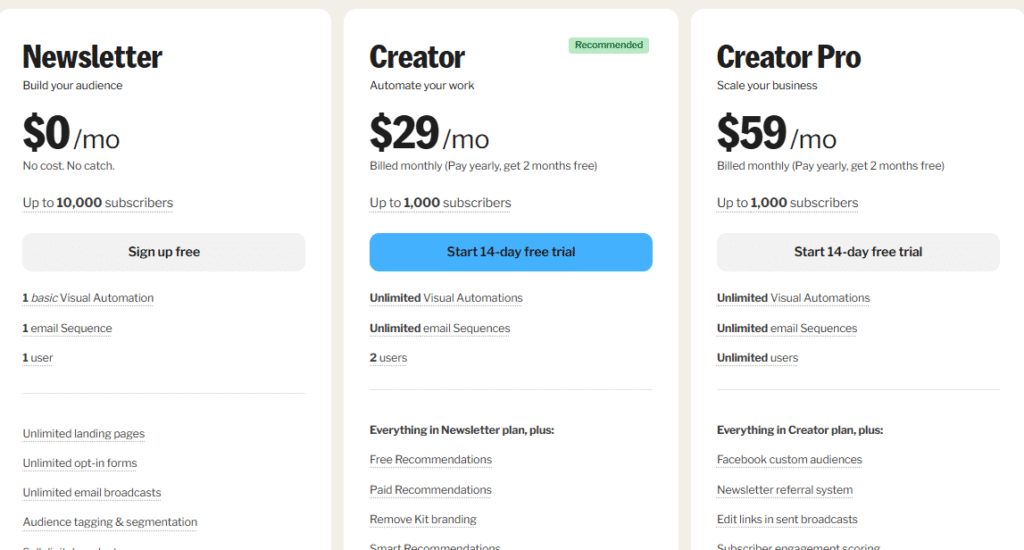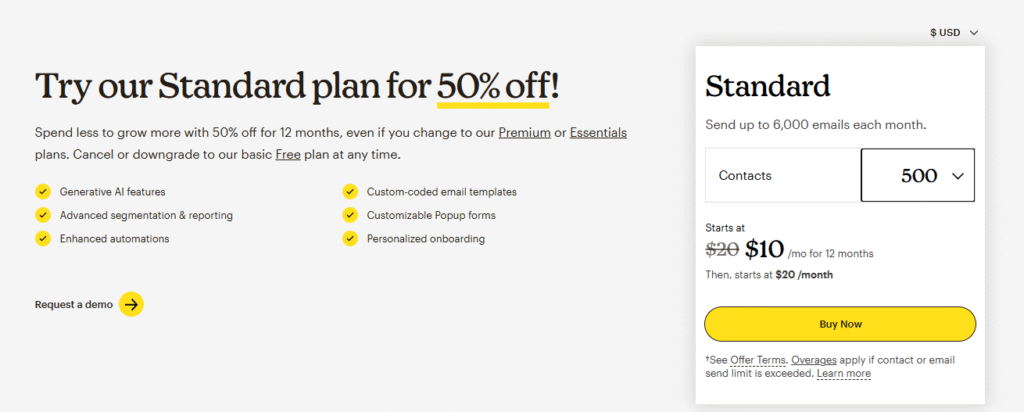ConvertKit vs Mailchimp email marketing tool can define your success in 2025. Both platforms are leaders in email marketing, but which one suits your business needs better? This in-depth ConvertKit vs Mailchimp comparison covers features, pricing, automation, ease of use, and much more to help you decide.
Quick Overview of ConvertKit vs Mailchimp in 2025
If you’re short on time, here’s a quick ConvertKit vs Mailchimp comparison summary:
| Feature | ConvertKit | Mailchimp |
|---|---|---|
| Ease of Use | ✅ Very intuitive | ✅ Beginner-friendly |
| Automation | ✅ Visual and simple | ✅ Advanced with a steeper learning curve |
| Audience Tags | ✅ Yes | ✅ Yes |
| Free Plan | ✅ Up to 1,000 subscribers | ✅ Up to 500 contacts |
| Landing Pages | ✅ Built-in | ✅ Built-in |
| E-commerce Tools | ❌ Limited | ✅ Extensive |
| Best For | Creators, bloggers, online entrepreneurs | Small businesses, e-commerce, startups |
Key Features in the ConvertKit vs Mailchimp Battle
ConvertKit Features Explained
ConvertKit targets creators who want a streamlined experience:
- Visual automation builder for easy email sequences
- Tag-based subscriber management for smart segmentation
- Unlimited landing pages and sign-up forms included
- Clean, subscriber-focused dashboard
- Built-in email templates to save time
Mailchimp Features at a Glance
Mailchimp provides a full marketing suite for businesses:
- Email automation from basic to advanced
- Detailed segmentation and A/B testing for optimization
- Website and ad-building tools integrated
- Drag-and-drop email editor with customizable templates
- E-commerce integration with Shopify, WooCommerce, and others
Personal Experience: ConvertKit vs Mailchimp in Action
Using ConvertKit for Email Marketing
ConvertKit offers simplicity and focus, especially for bloggers and creators who want to grow their audience effortlessly.
Pros:
- Intuitive interface and clean design
- Easy automation and tagging
- Strong deliverability
Cons:
- Limited design options
- Fewer integrations compared to Mailchimp
Using Mailchimp in Real Life
Mailchimp suits businesses needing more features, especially e-commerce and marketing agencies.
Pros:
- Comprehensive toolset in one platform
- Powerful analytics and segmentation
- Great for online stores
Cons:
- Steeper learning curve
- Interface can be overwhelming
- Higher cost as lists grow
Pricing Breakdown: ConvertKit vs Mailchimp
ConvertKit Pricing Details
Free plan: Up to 1,000 subscribers with basic automation
Creator Plan: Starting at $29/month with advanced features
Creator Pro: From $59/month including premium options like Facebook audiences and team support

Mailchimp Pricing Overview
- Free plan: Up to 500 contacts, limited tools
- Essentials: From $13/month with A/B testing and templates
- Standard: From $20/month with automation and analytics
- Premium: From $350/month for enterprise needs

Note: Mailchimp pricing includes unsubscribed contacts, increasing costs as your list grows.
Pros and Cons Summary of ConvertKit vs Mailchimp
ConvertKit Advantages and Disadvantages
Pros:
- Tailored for creators and bloggers
- User-friendly automation workflows
- Clean subscriber management
Cons:
- Limited email design flexibility
- Fewer integrations
- No native A/B testing
Mailchimp Advantages and Disadvantages
Pros:
- All-in-one marketing platform
- Advanced analytics and segmentation
- Strong e-commerce support
Cons:
- Complex for beginners
- Can get expensive quickly
- Cluttered interface at times
Alternatives to ConvertKit and Mailchimp in 2025
| Tool | Best For | Starting Price |
|---|---|---|
| Systeme.io | Funnels & email marketing | Free plan available |
| MailerLite | Affordable email marketing | Free up to 1,000 subscribers |
| GetResponse | Automation & webinars | Free plan available |
| ActiveCampaign | CRM and automation | From $9/month |
Deliverability and Analytics: ConvertKit vs Mailchimp
Email Deliverability
- ConvertKit maintains high deliverability due to clean practices.
- Mailchimp performs well but can struggle with inactive lists.
Analytics and Reporting
- Mailchimp offers detailed behavior reports and customer journey tracking.
- ConvertKit provides essential open/click data and automation stats.
When to Choose ConvertKit vs Mailchimp
Best Use Cases for ConvertKit
- Content creators and bloggers
- Users wanting simple, focused email automation
- Those not needing full marketing suites
Best Use Cases for Mailchimp
- Small businesses and e-commerce stores
- Users needing advanced segmentation and analytics
- Those wanting integrated website and ad tools
Conclusion: Which Is the Better Email Marketing Tool?
So, who wins the ConvertKit vs Mailchimp battle in 2025? The answer depends on your needs.
- If you’re a creator, ConvertKit is the clear winner with its clean interface, automation-first approach, and focus on audience building.
- If you’re a small business or e-commerce brand, Mailchimp provides a more comprehensive toolkit, though at a higher price and complexity.
Final Verdict:
- Choose ConvertKit for focused content marketing and simplicity.
- Choose Mailchimp for scalability, e-commerce, and deeper marketing features.
Ready to start building your email list? Check out our Systeme.io review or sign up for a free all-in-one tool here.
If you want to learn more about the best marketing tools and strategies to grow your online business, you need to explore reliable resources that help you stay ahead in digital marketing. For in-depth guides, reviews, and tips, visit Pasive Marketer and take your marketing skills to the next level.



![You are currently viewing ConvertKit vs Mailchimp [2025] – Which Email Marketing Tool is Best?](https://pasivemarketer.com/wp-content/uploads/2025/06/ChatGPT-Image-Jun-6-2025-03_51_49-PM.webp)


